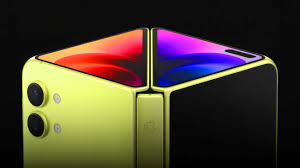After years of speculation, Apple’s long-awaited entry into the foldable smartphone market is finally taking shape. Leaks surrounding the company’s first foldable iPhone have surfaced, revealing a device that could redefine the iPhone experience and challenge the dominance of Samsung’s Galaxy Z Fold series. Internally codenamed “V68,” the foldable iPhone is expected to launch in the fall of 2026, potentially alongside the iPhone 18 lineup. While Apple has remained characteristically silent, the details emerging from supply chain sources and industry insiders paint a compelling picture of what might be the most radical iPhone redesign in over a decade.
A Book-Style Foldable Design
Apple’s foldable iPhone is rumored to adopt a book-style design, similar to the Galaxy Z Fold series. When unfolded, the device transforms into a tablet-like experience with a large internal display. Leaks suggest the main screen will measure approximately 7.8 inches, while the cover display will be around 5.5 inches. This dual-screen setup aims to offer both portability and productivity, allowing users to switch seamlessly between compact and expansive modes.
The device is expected to be impressively thin, measuring just 4.5mm when open and about 9mm when folded. Apple’s engineering team is reportedly focused on minimizing bulk while maintaining durability, a challenge that has plagued many foldable devices in the past. The hinge mechanism is said to be reinforced with a composite material that balances strength and flexibility, ensuring smooth folding without compromising structural integrity.
Creaseless Display Technology
One of the most common complaints about foldable phones is the visible crease that forms along the folding axis. Apple appears determined to solve this issue by implementing in-cell touchscreen technology. Unlike traditional on-cell panels, in-cell displays integrate the touch sensors directly into the screen layers, reducing air gaps and improving responsiveness. This approach could result in a smoother, more uniform display surface with minimal crease visibility.
Early prototypes reportedly featured on-cell panels, but Apple engineers found that they left noticeable air pockets near the hinge. The shift to in-cell technology is a strategic move to deliver a premium visual experience that aligns with Apple’s reputation for display excellence.
Quad-Camera Setup
The foldable iPhone is expected to feature a total of four cameras. This includes one on the front cover for selfies and video calls, one on the inner display for FaceTime and conferencing, and a dual-camera setup on the rear. The rear cameras are rumored to include a high-resolution primary sensor and either an ultra-wide or telephoto lens, offering versatility for photography enthusiasts.
While exact megapixel counts remain unconfirmed, analysts believe Apple will continue its trend of upgrading camera hardware across the board. The inclusion of multiple cameras on a foldable device suggests Apple is serious about maintaining its imaging standards, even in a radically new form factor.
Touch ID Returns
In a surprising twist, Apple may be bringing back Touch ID for its foldable iPhone. The biometric sensor is expected to be integrated into the side button, replacing Face ID. This decision is reportedly driven by space constraints within the slim chassis, as the components required for Face ID are difficult to accommodate in a foldable design.
Touch ID offers a smaller footprint and has proven reliable in previous iPhone models. Its return could also appeal to users who prefer fingerprint authentication over facial recognition. This move marks a notable shift in Apple’s biometric strategy and could influence future iPhone designs.
eSIM-Only Connectivity
Apple’s foldable iPhone is rumored to eliminate the physical SIM card slot entirely, relying solely on eSIM technology. This aligns with Apple’s broader push toward digital-only connectivity, which began with select iPhone models in recent years. The foldable device will reportedly feature Apple’s in-house C2 modem, a second-generation chip designed to improve cellular performance and reduce dependency on third-party suppliers.
The adoption of eSIM-only connectivity could streamline the device’s internal layout, freeing up space for other components and contributing to its slim profile. It also reflects Apple’s commitment to controlling more aspects of its hardware ecosystem.
Color Options and Materials
Initial leaks suggest the foldable iPhone will be available in black and white, with additional colors possibly introduced post-launch. Apple is known for its restrained approach to color in first-generation products, often expanding the palette in subsequent iterations based on user feedback.
The device is expected to feature a titanium frame, enhancing durability while keeping weight in check. Titanium has already made its way into Apple’s premium devices, including the Apple Watch Ultra and iPhone Pro models, and its inclusion here signals a focus on premium materials and long-term resilience.
Software Experience
While details about the software are limited, it’s safe to assume that Apple will optimize iOS for the foldable form factor. This could include enhanced multitasking features, split-screen support, and dynamic app scaling. Apple’s track record with software integration suggests that the foldable iPhone will deliver a seamless experience that adapts to both folded and unfolded modes.
Developers may also gain access to new APIs that allow apps to take advantage of the larger screen real estate and dual-display setup. This could lead to a wave of foldable-optimized apps that enhance productivity and entertainment.
Pricing and Market Positioning
The foldable iPhone is expected to carry a premium price tag, with estimates hovering around $1,999 or approximately ₹1.75 lakh in India. This positions it as a luxury device aimed at early adopters and loyal Apple users. While the price may seem steep, it’s in line with other flagship foldables from Samsung and Huawei.
Apple’s strategy appears to focus on delivering a polished, high-end product rather than competing on price. The foldable iPhone could become a status symbol, much like the original iPhone did in 2007, and its success may depend on how well it integrates into Apple’s broader ecosystem.
Production Timeline and Launch Window
Suppliers are reportedly preparing for mass production in early 2026, with a launch targeted for the fall. This timing aligns with Apple’s traditional release cycle and suggests the foldable iPhone could debut alongside the iPhone 18 series. The company is said to be conducting extensive testing to ensure the device meets its high standards before entering full-scale production.
While Apple has been late to the foldable party, its methodical approach may pay off. By learning from the shortcomings of existing foldables and applying its design philosophy, Apple has the potential to redefine the category.
Final Thoughts
The foldable iPhone represents Apple’s most significant design shift in years. With a book-style form factor, creaseless display technology, quad-camera setup, Touch ID integration, and eSIM-only connectivity, the device is poised to offer a unique blend of innovation and refinement. While many details remain speculative, the leaks suggest that Apple is serious about entering the foldable market with a product that reflects its core values of simplicity, elegance, and performance.
As the launch window approaches, anticipation will only grow. If Apple delivers on the promise of these leaks, the foldable iPhone could become the next big leap in mobile technology, reshaping how users interact with their devices and setting a new benchmark for the industry.



